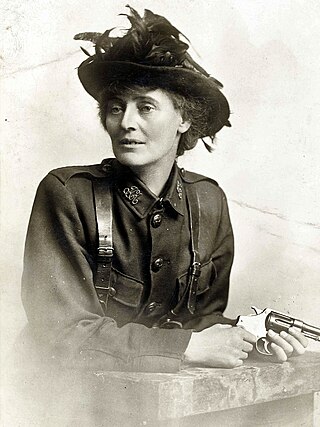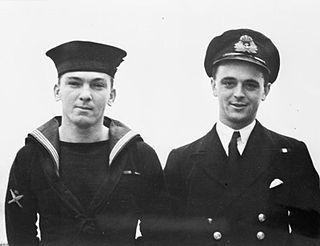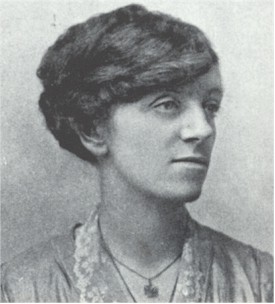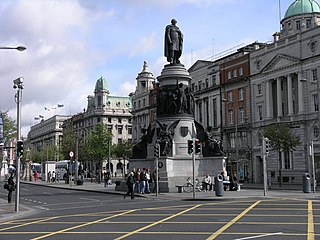Biography
Elizabeth McLaughlin is from Ballygowan in Newtownards, County Down. [1] Very little is known about the artist. When one of her statues was damaged and stolen after Storm Ophelia the local community of Finglas, where the statue was displayed, tried to reach out to the artist. The statue was found and repaired but the McLaughlin was not found for the ceremony to replace the piece. [2] [3]
McLaughlin has a number of well known sculptures commissioned and on display in Ireland. The best known of these are the Countess Markievicz and Poppet Statue in Dublin, [4] [5] the Claudy bombing memorial [1] and the Finglas Mother and Baby statue more correctly known by its title Let the Life Flow Through. Others include a statue commemorating the Famine in Roscommon, [6] a memorial to James Joseph Magennis, [7] [8] and Let There Be Light [9] which includes stained glass as well as the more typical bronze with which McLaughlin usually works.
Constance Markievicz statue
Let the Life Flow Through
Claudy bombing memorial
Leading Seaman Magennis VC

Na Fianna Éireann, known as the Fianna, is an Irish nationalist youth organisation founded by Constance Markievicz in 1909, with later help from Bulmer Hobson. Fianna members were involved in setting up the Irish Volunteers, and had their own circle of the Irish Republican Brotherhood (IRB). They took part in the 1914 Howth gun-running and in the 1916 Easter Rising. They were active in the War of Independence and many took the anti-Treaty side in the Civil War.

Edward Delaney was an Irish sculptor born in Claremorris in County Mayo in 1930. His best-known works include the 1967 statue of Wolfe Tone and famine memorial at the northeastern corner of St Stephen's Green in Dublin and the statue of Thomas Davis in College Green, opposite Trinity College Dublin. These are both examples of lost-wax bronze castings, his main technique during the 1960s and early 1970s.

Constance Georgine Markievicz, also known as Countess Markievicz and Madame Markievicz, was an Irish politician, revolutionary, nationalist, suffragist, socialist, and the first woman elected to the Westminster Parliament. She was elected Minister for Labour in the First Dáil, becoming the second female cabinet minister in Europe. She served as a Teachta Dála for the Dublin South constituency from 1921 to 1922 and 1923 to 1927. She was a Member of Parliament (MP) for Dublin St Patrick's from 1918 to 1922.

St Stephen's Green is a garden square and public park located in the city centre of Dublin, Ireland. The current landscape of the park was designed by William Sheppard. It was officially re-opened to the public on Tuesday, 27 July 1880 by Lord Ardilaun. The square is adjacent to one of Dublin's main shopping streets, Grafton Street, and to a shopping centre named after it, while on its surrounding streets are the offices of a number of public bodies as well as a stop on one of Dublin's Luas tram lines. It is often informally called Stephen's Green. At 22 acres (8.9 ha), it is the largest of the parks in Dublin's main Georgian garden squares. Others include nearby Merrion Square and Fitzwilliam Square.
Events in the year 1972 in Ireland.

James Joseph Magennis, VC was a Belfast-born sailor and recipient of the Victoria Cross, the highest award for gallantry in the face of the enemy that can be awarded to British and Commonwealth forces. He was the only native of Northern Ireland to receive the Victoria Cross in the Second World War.

William Frederick McFadzean VC was a British recipient of the Victoria Cross (VC), the highest and most prestigious award for gallantry in the face of the enemy that can be awarded to British and Commonwealth forces. He was posthumously awarded the VC for his actions on the opening day of the Battle of the Somme.

Whitehall is a Northside suburb of Dublin City, Ireland.

Belfast City Hall is the civic building of Belfast City Council located in Donegall Square, Belfast, Northern Ireland. It faces North and effectively divides the commercial and business areas of the city centre. It is a Grade A listed building.

The Claudy bombing occurred on 31 July 1972, when three car bombs exploded mid-morning, two on Main Street and one on Church Street in Claudy in County Londonderry, Northern Ireland. The attack killed nine civilians, injured thirty and became known as "Bloody Monday". Those who planted the bombs had attempted to send a warning before the explosions took place. The warning was delayed, however, because the telephones were out of order due to an earlier bomb attack. The Provisional Irish Republican Army (IRA) issued an immediate denial of responsibility, and later stated that "an internal court of inquiry" had found that its local unit did not carry out the attack. On the thirtieth anniversary of the bombing, there was a review of the case and in December 2002 it was revealed that the IRA had been responsible for the bomb explosions.

Maria Winifred "Winnie" Carney, was an Irish republican, a participant in the 1916 Easter Rising in Dublin, and in Belfast—as a trade union secretary, women's suffragist, and socialist party member—a lifelong social and political activist. In March 2024, a statue to her was unveiled on the grounds of Belfast City Hall.
Patricia Black, also known as smiler or Patricia Black-Donnelly was a Volunteer in the Belfast Brigade of the Provisional Irish Republican Army (IRA). She was killed in St Albans in 1991 when a bomb she was carrying exploded prematurely.
Carolyn MulhollandHRHA, HRUA is an Irish sculptor.

The Oscar Wilde Memorial Sculpture is a collection of three statues in Merrion Square in Dublin, Ireland, commemorating Irish poet and playwright Oscar Wilde. The sculptures were unveiled in 1997 and were designed and made by Danny Osborne.

The County Fermanagh War Memorial stands in Enniskillen, County Fermanagh, Northern Ireland. It was originally constructed to commemorate the men of the town killed during the First World War, particularly those serving with the local regiments, the 6th (Inniskilling) Dragoons and the Royal Inniskilling Fusiliers. It was later altered to also commemorate those killed in the Second World War.

The O'Connell Monument is a 40 ft high commemorative granite and bronze monument honouring nationalist leader Daniel O'Connell (1775–1847) located on O'Connell Street, the main thoroughfare of Dublin, Ireland.
This page is based on this
Wikipedia article Text is available under the
CC BY-SA 4.0 license; additional terms may apply.
Images, videos and audio are available under their respective licenses.
















